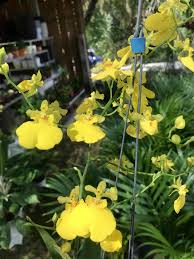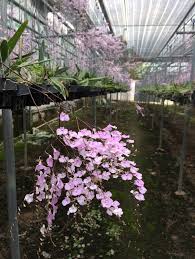
Transporting Oncidium orchids, commonly known as “dancing lady orchids,” over long distances requires careful planning and execution to ensure their health and vitality upon arrival. These beautiful flowers, prized for their vibrant colors and unique shapes, can be sensitive to environmental changes, making it essential to understand the best practices for their transport. This comprehensive guide will cover the essential considerations, tips, and methods for successfully transporting Oncidium orchids over long distances while minimizing stress and ensuring they thrive in their new environment.
## 1. Understanding Oncidium Orchids
### 1.1 Characteristics of Oncidium Orchids
Oncidium orchids belong to the family Orchidaceae and are known for their unique, delicate flowers that resemble a dancing lady. These epiphytic plants thrive in their natural habitats of tropical and subtropical regions of Central and South America, where they grow on trees and rocks. Understanding the characteristics of Oncidium orchids is crucial for proper handling and transport.
### 1.2 Growing Requirements
Oncidium orchids require specific growing conditions, including:
– **Light**: They prefer bright, indirect light, which helps promote healthy growth and blooming.
– **Humidity**: High humidity levels (40-70%) are essential for their health.
– **Temperature**: They thrive in temperatures ranging from 65°F to 80°F (18°C to 27°C).
– **Watering**: Proper watering practices are vital to prevent root rot and dehydration.
These growing requirements must be considered during transportation to ensure the orchids remain healthy.
## 2. Preparing for Transportation
Before embarking on the transportation process, it’s crucial to prepare your Oncidium orchids properly. This preparation will help minimize stress and increase their chances of thriving in their new location.
### 2.1 Assessing Plant Health
Prior to transport, evaluate the health of your orchids:
– **Inspect for Pests and Diseases**: Check for any signs of pests or diseases, such as discolored leaves or wilting. Treat any issues before transport to prevent spreading during the journey.
– **Trim Dead or Damaged Leaves**: Remove any dead or damaged foliage to reduce the risk of disease and improve air circulation.
– **Assess Root Health**: Ensure the roots are healthy and well-established. Trim any rotting or damaged roots to promote healthy growth after transport.
### 2.2 Potting Considerations
Consider the potting setup before transportation:
– **Choose Appropriate Pots**: If your orchids are potted in fragile pots, consider transferring them to sturdier containers for transport.
– **Secure the Plant**: Ensure that the orchid is securely potted, with enough medium to hold it in place during transit. Avoid loose potting materials that could shift and cause damage.
### 2.3 Timing the Transport
Timing is critical when transporting orchids:
– **Consider Weather Conditions**: Choose a day with moderate temperatures to avoid exposing the orchids to extreme heat or cold during transport. Avoid transporting on days with severe weather conditions, such as high winds or heavy rain.
– **Transport During Cooler Hours**: If possible, transport orchids in the early morning or late evening when temperatures are cooler.
## 3. Packing the Orchids for Transport
Proper packing is essential for protecting your Oncidium orchids during transit. A well-packed orchid will be less prone to damage from movement, temperature fluctuations, and other environmental factors.
### 3.1 Materials Needed for Packing
Gather the following materials for packing:
– **Cardboard Boxes**: Choose sturdy boxes that can withstand the weight of the orchids and provide ample protection.
– **Bubble Wrap or Foam Padding**: Use these materials to cushion the orchids and protect them from bumps and jostling during transport.
– **Plastic Bags**: Use breathable plastic bags to cover the foliage and minimize moisture loss without trapping humidity.
– **Tissue Paper or Newspaper**: These can be used for additional padding around the orchids.
### 3.2 Packing Steps
Follow these steps to pack your Oncidium orchids securely:
1. **Prepare the Box**: Line the bottom of the box with bubble wrap or foam padding to create a cushioned base.
2. **Wrap the Orchid**: Gently wrap the orchid in tissue paper or newspaper, covering the leaves and flowers without crushing them. Avoid wrapping too tightly, as this can cause damage.
3. **Secure the Roots**: If the roots are exposed, wrap them in a damp paper towel to keep them hydrated during transport. Place them in a plastic bag to retain moisture.
4. **Position in the Box**: Place the wrapped orchid upright in the box, ensuring it is stable and won’t move during transport. Add additional padding around the orchid to prevent shifting.
5. **Seal the Box**: Close the box securely and label it as “Fragile” to alert handlers to treat it with care.
### 3.3 Temperature Control
Maintaining the right temperature during transport is vital for orchid health:
– **Insulation**: Use insulated boxes or thermal wraps to help maintain a stable temperature inside the box, especially if transporting in extreme weather conditions.
– **Avoid Direct Sunlight**: Keep the orchids out of direct sunlight during transport to prevent overheating.
## 4. Transportation Methods
Choosing the right transportation method can make a significant difference in the health of your Oncidium orchids upon arrival. Consider the following options:
### 4.1 Personal Vehicle Transport
If you are transporting your orchids in your vehicle, consider the following tips:
– **Temperature Regulation**: Keep the vehicle at a stable temperature, avoiding extreme heat or cold. Use air conditioning or heating as needed.
– **Secure Placement**: Place the box in a secure area of the vehicle, ensuring it won’t tip or slide during transport.
### 4.2 Commercial Shipping
If you are shipping orchids via a courier or shipping service, take these factors into account:
– **Choose a Reputable Carrier**: Select a shipping company experienced in handling live plants. Look for services that specialize in shipping orchids or other delicate plants.
– **Shipping Time**: Opt for expedited shipping options to minimize transit time. The less time your orchids spend in transit, the better.
– **Shipping Conditions**: Ensure the shipping company provides temperature-controlled shipping options, especially for longer distances.
### 4.3 Air Travel Considerations
If you are flying with your orchids, adhere to these guidelines:
– **Check Airline Regulations**: Review the airline’s policies regarding transporting live plants. Some airlines may have restrictions or specific requirements for transporting orchids.
– **Carry-On Option**: If possible, carry your orchids as carry-on luggage to monitor them closely during the flight.
– **Notify Security**: Inform security personnel that you are carrying live plants, as they may need to inspect them.
## 5. Post-Transport Care
Once your Oncidium orchids arrive at their new destination, providing appropriate care is essential for helping them recover from the stress of transport.
### 5.1 Unpacking and Inspection
Upon arrival, carefully unpack your orchids:
– **Examine the Plant**: Inspect for any damage or signs of stress, such as wilting or browning leaves. Take note of any issues that may need addressing.
– **Remove Packaging Materials**: Carefully remove all packing materials without damaging the plant.
### 5.2 Acclimating the Orchids
Gradually acclimate your orchids to their new environment:
– **Gradual Exposure**: If the temperature or humidity levels differ significantly from their previous environment, allow them to acclimate slowly. Place them in a location with similar conditions for a few days before moving them to their permanent spot.
– **Avoid Direct Sunlight**: Keep the orchids out of direct sunlight for the first few days to reduce stress.
### 5.3 Watering and Nutrition
After transport, providing the right care is crucial:
– **Watering**: Check the moisture level of the potting medium. If it feels dry, water the orchids thoroughly, but avoid overwatering.
– **Nutrient Supplementation**: Wait about a week after transport before fertilizing to give the orchids time to recover. When you do fertilize, use a diluted, balanced orchid fertilizer.
### 5.4 Monitoring Health
Keep a close eye on your orchids in the days following transport:
– **Regular Checks**: Monitor for signs of stress, such as wilting, yellowing leaves, or pest infestations. Address any issues promptly.
– **Patience**: Understand that it may take time for your orchids to adjust to their new environment. Be patient and provide consistent care.
## 6. Troubleshooting Common Issues
Even with careful planning, challenges may arise when transporting Oncidium orchids. Here are some common issues and how to address them:
### 6.1 Wilting or Drooping Leaves
**Possible Causes**: Lack of water during transit or exposure to extreme temperatures.
**Solutions**:
– If the leaves are wilting, ensure the plant receives adequate water, but avoid overwatering.
– Monitor the temperature and humidity levels in the new environment and adjust as necessary.
### 6.2 Yellowing Leaves
**Possible Causes**: Stress from transport, insufficient light, or nutrient deficiencies.
**Solutions**:
– Ensure the orchids are in a well-lit area with bright, indirect light.
– Check the potting medium for nutrient deficiencies and consider fertilizing after they have acclimated.
### 6.3 Flower Drop
**Possible Causes**: Environmental stress or inadequate hydration.
**Solutions**:
– Minimize stress by maintaining stable temperature and humidity levels.
– Ensure the plant receives enough water without overwatering.
## 7. Conclusion
Transporting Oncidium orchids over long distances requires careful planning, preparation, and post-transport care. By understanding their unique characteristics and growing requirements, you can minimize stress and ensure they thrive in their new environment.
From assessing plant health and choosing appropriate packing materials to selecting the right transportation method
, every step plays a crucial role in the successful transport of these beautiful orchids. Once they arrive, proper acclimation and ongoing care will help your Oncidium orchids flourish, allowing you to enjoy their stunning blooms for years to come.
With the right approach, you can confidently transport your Oncidium orchids, preserving their beauty and vitality along the way. Embrace the journey of transporting these exquisite plants, and watch as they continue to bring joy and elegance to your home or garden.


